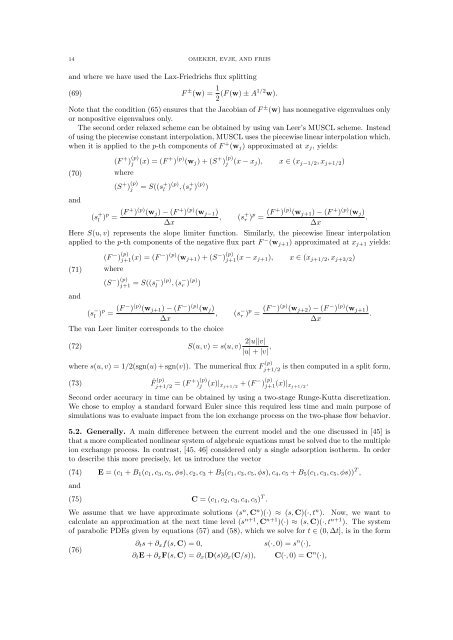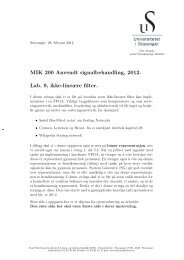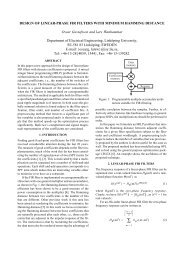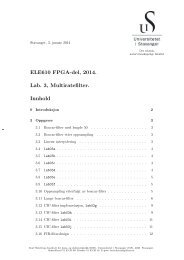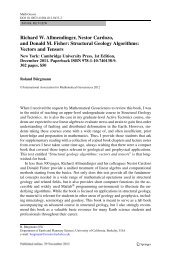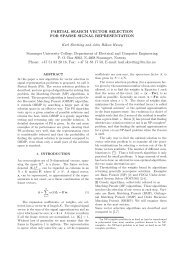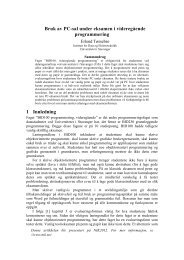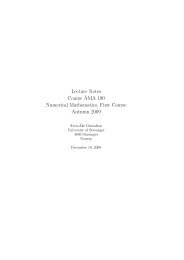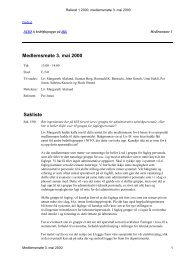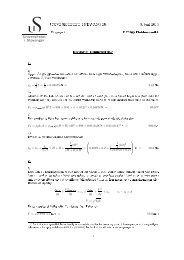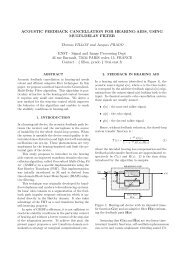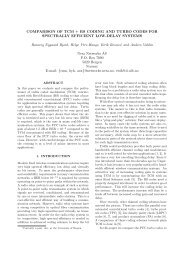MODELING OF LOW SALINITY EFFECTS IN SANDSTONE OIL ...
MODELING OF LOW SALINITY EFFECTS IN SANDSTONE OIL ...
MODELING OF LOW SALINITY EFFECTS IN SANDSTONE OIL ...
Create successful ePaper yourself
Turn your PDF publications into a flip-book with our unique Google optimized e-Paper software.
14 OMEKEH, EVJE, AND FRIISand where we have used the Lax-Friedrichs flux splitting(69)F ± (w) = 1 2 (F (w) ± A1/2 w).Note that the condition (65) ensures that the Jacobian of F ± (w) has nonnegative eigenvalues onlyor nonpositive eigenvalues only.The second order relaxed scheme can be obtained by using van Leer’s MUSCL scheme. Insteadof using the piecewise constant interpolation, MUSCL uses the piecewise linear interpolation which,when it is applied to the p-th components of F + (w j ) approximated at x j , yields:(70)and(F + ) (p)j (x) = (F + ) (p) (w j ) + (S + ) (p)j (x − x j ), x ∈ (x j−1/2 , x j+1/2 )where(S + ) (p)j = S((s + l )(p) , (s + r ) (p) )(s + l )p = (F + ) (p) (w j ) − (F + ) (p) (w j−1 )∆x, (s + r ) p = (F + ) (p) (w j+1 ) − (F + ) (p) (w j ).∆xHere S(u, v) represents the slope limiter function. Similarly, the piecewise linear interpolationapplied to the p-th components of the negative flux part F − (w j+1 ) approximated at x j+1 yields:(71)and(F − ) (p)j+1 (x) = (F − ) (p) (w j+1 ) + (S − ) (p)j+1 (x − x j+1), x ∈ (x j+1/2 , x j+3/2 )where(S − ) (p)j+1 = S((s− l )(p) , (s − r ) (p) )(s − l )p = (F − ) (p) (w j+1 ) − (F − ) (p) (w j ), (s − r ) p = (F − ) (p) (w j+2 ) − (F − ) (p) (w j+1 ).∆x∆xThe van Leer limiter corresponds to the choice(72)S(u, v) = s(u, v) 2|u||v||u| + |v| ,where s(u, v) = 1/2(sgn(u) + sgn(v)). The numerical flux F (p)j+1/2is then computed in a split form,(73)ˆF (p)j+1/2 = (F + ) (p)j (x)| xj+1/2 + (F − ) (p)j+1 (x)| x j+1/2.Second order accuracy in time can be obtained by using a two-stage Runge-Kutta discretization.We chose to employ a standard forward Euler since this required less time and main purpose ofsimulations was to evaluate impact from the ion exchange process on the two-phase flow behavior.5.2. Generally. A main difference between the current model and the one discussed in [45] isthat a more complicated nonlinear system of algebraic equations must be solved due to the multipleion exchange process. In contrast, [45, 46] considered only a single adsorption isotherm. In orderto describe this more precisely, let us introduce the vector(74) E = (c 1 + B 1 (c 1 , c 3 , c 5 , ϕs), c 2 , c 3 + B 3 (c 1 , c 3 , c 5 , ϕs), c 4 , c 5 + B 5 (c 1 , c 3 , c 5 , ϕs)) T ,and(75) C = (c 1 , c 2 , c 3 , c 4 , c 5 ) T .We assume that we have approximate solutions (s n , C n )(·) ≈ (s, C)(·, t n ). Now, we want tocalculate an approximation at the next time level (s n+1 , C n+1 )(·) ≈ (s, C)(·, t n+1 ). The systemof parabolic PDEs given by equations (57) and (58), which we solve for t ∈ (0, ∆t], is in the form(76)∂ t s + ∂ x f(s, C) = 0, s(·, 0) = s n (·),∂ t E + ∂ x F(s, C) = ∂ x (D(s)∂ x (C/s)), C(·, 0) = C n (·),


